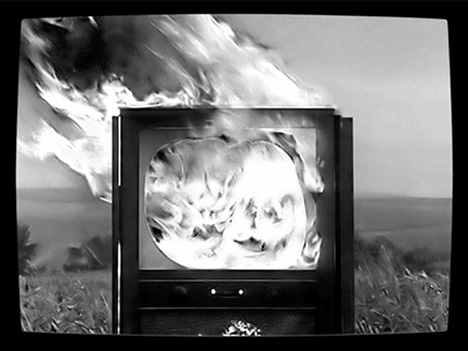In a recent article entitled Television Amongst Friends: Medium, Art, Media, Sarah Cardwell challenges the definition of television as a ‘medium’, proposing instead that ‘television be regarded as an art composed of many media’ (2014: 6). Television as an artistic medium is a concept I’ve briefly alluded to in a previous post in which I considered how art is defined within the context of broadcasting. In this post I want to delve a little further into the discussion around television’s place and, of course, value within this predefined notion of ‘the arts’.
As Cardwell writes in the aforementioned article:
An over-emphasis on TV’s communicative rather than artistic functions separates ‘the media’ from ‘the arts’. As one’s interest turns to the dramatic content of television, especially fictional content, does it really make sense to place television within a different category from other narrative arts such as theatre and film (and isolate it completely from non-narrative arts such as painting and sculpture)? The distinction between television-as-medium (television-as-conveyor of popular/mass communication) and ‘art proper’ serves to sustain the barricades between television and other arts
(2014: 9)
This raises interesting questions around what exactly distinguishes television from the arts in both form and content, and how this dichotomy may merely serve to sustain a preconceived hierarchy of cultural value.
If we consider the arts in the context of television as a medium for mass communication then we are perhaps led to the assumption that television can only represent ideas about the arts, rather than be a legitimate medium for artistic expression in itself. But this is perhaps to ignore the long history of the visual arts being used as a medium for communicating ideas to the masses. You only have to look at the stained glass windows that adorn the walls of churches depicting biblical narratives for the predominantly illiterate medieval worshippers to see how ideas around morality and faith have been communicated through art to a collective audience.
Arguments that distinguish television from art by emphasising its role as a medium for mass communication also become somewhat unstuck when we consider content that is defined by its very lack of ideological structure. A few months back I discussed whether ‘slow TV’ could be considered conceptual art. Comparing the genre’s recent proliferation in Norway to Andy Warhol’s 1964 film Sleep, I outlined how this form of “anti-television” challenged our preconceptions of what television should or should not be. The most prominent way this is achieved is through the lack of distinct narrative, leaving the viewer with somewhat of a ‘blank canvas’. If we conceptualise television as a medium for the broadcast of ideas and meaning, then it seems difficult to place slow TV within this context.
There have also been instances of artists creating works specifically for broadcasting on television. A notable example is the late David Hall’s ‘Tap Piece’ from 1971, which features a tap filling the screen with water without any form of explanation or context.
This, arguably the most memorable of the seven ‘TV interruptions’ created by Hall, demonstrates how television can be used as a medium for more abstract and avant-garde forms of artistic expression. It is clear that Hall’s work is created specifically for television, with the unexpected nature of the ‘interruption’ being comparable to that of the breaking news broadcast or the susceptibility of analogue television signals to interference. It is the breaking of this ‘flow’ that makes the piece striking and catches the audience’s attention.
So does this mean that television must always subvert its own norms in order to facilitate artistic expression? What makes drama written for television or radio different from that written for and performed on stage, for example? Or if you were to project the latest fragrance commercial from Paco Rabanne onto the wall of an art gallery and remove the references to the actual product, would people think it was a masterpiece?
If we move beyond the highbrow/lowbrow culture dichotomy, which can sometimes be seen as both a start and end point in these sort of debates, we can perhaps consider some other aspects of television that distinguish it from the art world in the minds of both viewers and critics.
To return to the example of the abstract and often bizarre fragrance commercials, there’s the issue of the intention behind the piece. It’s rather doubtful that Paco Rabanne is using the commercial break between Hollyoaks to portray an insight into the human soul (and God help us if they are). The notion of commercial gain that drives these pieces seems to contradict the romantic vision of the artist as placing more value on their work than economic reward.
There is also the collaborative aspect of television production. Many of the works that constitute the canon of art within our culture can be attributed to a single person. Van Gogh’s sunflowers, Tracey Emin’s bed, Tchaikovsky’s symphonies. However, with television it is often hard to pinpoint a singular source of artistic vision. Who is responsible for the aesthetic value of the finished piece? The scriptwriter? The director? The camera operator? Whilst each individual may have their claim to various levels of artistic influence within the production process, they are all essential in creating the finished piece.
So, although you may be hard pressed to find anyone who could confidently defend the artistic integrity of the Six O’Clock News or Jeremy Kyle, that’s not to say that all television should be placed in a box marked ‘not art’ and left in a bin round the back of the National Gallery. As video artists such as David Hall have demonstrated in the past, television can serve as an incredibly effective medium for artistic expression. However, if we want to further dismantle the cultural barriers that separate television from art, we need to perhaps look beyond the idea that the only way of creating ‘television art’ is through subverting the very norms that have come to define the medium.



